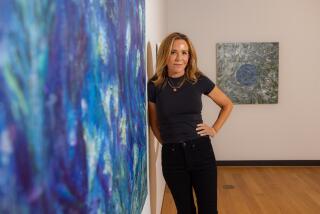‘Spirits of Forest’: Visions of Forces of Nature
- Share via
Credentials are hot these days in contemporary art--not the formal kind that link an artist with an academic institution, but an informal sort that announces itself within the artwork as a wry tribute to the work’s own genealogy. Artists have made work responding to earlier art for centuries, but never with as much self-consciousness as in the 1980s.
Shopping among the styles of the past, mixing and matching at will, has been pronounced a post-modern activity, a means of coping with both the exhaustive art historical past and the media-saturated present. However glib and pretentious the results of this process, the work’s connection to recognized art of the past lends it legitimacy of its own. The work is well pedigreed, but hardly passionate. It reeks of ambition and the fast track of fame.
At the opposite end of the spectrum (currently the much less popular end) are artists whose work delves into life itself rather than holding up a mirror to the machinations of the art world. Whether schooled in art or not, these artists have “unlearned” some of their acquired knowledge in order to seek a purer, more childlike mode of expression.
Their work has a tradition, too, the tradition of folk art, and in its current manifestations it is referred to variously as naive, outsider or primitivist art. Though a relatively quiet presence in the mainstream art world today, this work’s persistent vitality makes it an exhilarating antidote to the cerebral in-jokes of the self-consciously well-bred artist.
The Oneiros Gallery downtown (811 Eighth Ave.) has a predilection for such work, and is currently showing the paintings, prints and sculpture of Duane Schnabel. Schnabel lives in a log cabin in Idaho, where his advanced degrees in art wield only minor influence over his exuberant visions of the underlying forces of nature.
The show “Spirits of the Forest” proves Schnabel’s link to the unconscious urgings of the human spirit to be intact and telegraphic.
His images spread automatically across the paper surfaces to the surrounding frames, which Schnabel hand-crafts with scalloped edges, painted and incised patterns and shimmering glitter.
Like a continuous pulse of exclamation points, the frames amplify the energy of the images within. These densely packed visions of organic, sexual and animal forces are also tightly packed into the small gallery, intensifying their dazzling impact.
Heads stare outward from the images with blazing eyes and teeth like broken glass, birds float in their close-cropped spaces and stick figures, crosses and other demonic and mysterious entities hover about.
The paintings hum at a fevered pitch, their fields sparking with a heated, primal energy. Creatures encapsulated within other creatures suggest an unpeeling of the outer, conscious and controlled layers to reveal the melange of hidden forces within. Schnabel’s bold and lush palette of bright green, pink, blue, yellow and red further invigorates the images, packing them with an intensity matched by their thickly sculpted encaustic surfaces.
Schnabel’s show sparkles, literally, with a vibrancy and honesty so refreshing in these days of cynical chic. His paintings, and especially his small wood, bone, leather and shell sculptures of heads evoke an African and occasionally a Native American Indian sensibility in their suggestion of powerful, mystical myths.
Schnabel’s work is like a dance with life itself, a shedding of inhibition to commune with unspoken personal and universal impulses. His debut exhibition in San Diego, which continues through Dec. 10, both delights and enriches.
San Diego also boasts another living treasure in the folk tradition: Faith Ringgold, who teaches at UC San Diego part of each year and lives for the remainder in New York. Her long career in painting, fabric sculpture, masks, quilts and performance has received scant attention locally (most recently she appeared in a group show of UC women faculty), though she has been featured in numerous museum and gallery exhibitions throughout the country.
While certainly not an outsider to the contemporary art world, Ringgold draws upon traditions of story telling and quilt-making that set her work apart from the slick sophistry that dominates the gallery scene.
Her current show of painted story quilts at the Bernice Steinbaum Gallery in New York’s SoHo district (through Dec. 3) rests on a solid foundation of humanism, manifested in the quilts’ soft, accessible textures, their handwritten texts and their epic tales of physical and spiritual survival.
Ringgold has focused consistently on issues of racism, sexism and black self-determination in her work of the last 20 years. Here, these concerns emerge in the personal tales of distinct individuals. In the “Woman on a Bridge” series, Ringgold traces the dreams and visions of a young black girl, whose wish to fly over the city echoes a larger desire for freedom from racial tension and oppression.
In another quilt, Ringgold recounts her own experiences and feelings during her 100-pound weight loss, a tale that speaks eloquently of the power to change and empower oneself.
“The Bitter Nest” series of five quilts tells the story of a mother and daughter who lived during the Harlem Renaissance.
The richness and candor of the verbal account are mirrored in the scenes Ringgold paints in the center of each quilt. She renders the characters and the spaces they occupy in a flat, slightly naive manner that is both endearing and clear. Framed by geometric patterns of dyed and recycled fabrics, the images are as full of grace and humor as they are free of pretension.
Ringgold spares us the esoteric and didactic in her quilts. In the rich, storytelling tradition, she simply tells us the truth, embellished only with a smile and a glimmer of hope for the future.
More to Read
The biggest entertainment stories
Get our big stories about Hollywood, film, television, music, arts, culture and more right in your inbox as soon as they publish.
You may occasionally receive promotional content from the Los Angeles Times.










